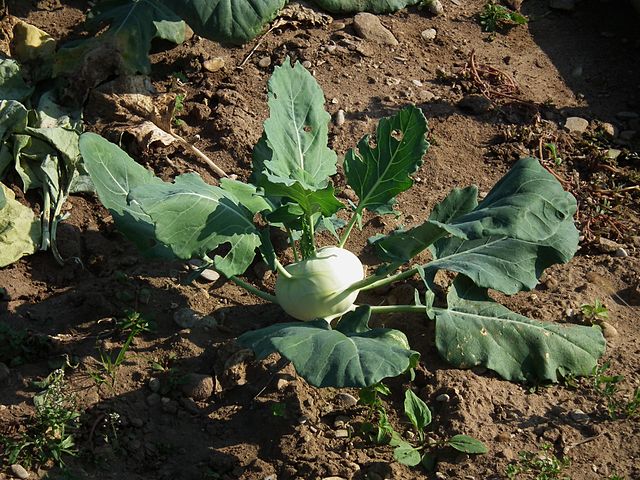Description
Kohlrabi has been created by artificial selection for lateral meristem growth (a swollen, nearly spherical shape); its origin in nature is the same as that of cabbage, broccoli, cauliflower, kale, collard greens, and Brussels sprouts: they are all bred from, and are the same species as, the wild cabbage plant (Brassica oleracea).
The taste and texture of kohlrabi are similar to those of a broccoli stem or cabbage heart, but milder and sweeter, with a higher ratio of flesh to skin. They can be eaten in a variety of ways - raw in salads, roasted, added to soups and stews, pureed, boiled, or mashed with potatoes.
Planting requirements
Planting season: Begin seedling preparation in nurseries by mid-August, followed by transplanting to the field in September
Planting conditions:
| Propagation | Direct seed or create transplants indoors |
|---|---|
| Planting method | Prepare beds and plant seeds at one inch spacing, and one-fourth to one-half inch deep. Maintain a 30 cm distance between each column. Planting after October in the mid and low country could lead to reduced yields due to high temperatures |
| Soil | Soil should have plenty of organic matter and mulch to trap moisture. Recommended pH level is 5.5 |
| Water | In the absence of rain apply one to one and a half inches of water per week |
| Light | 6 hours of sunlight per day |
Growing conditions:
| Temperatures | Optimal temperature range: 15-25°C |
|---|---|
| Soil | If humidity is low, help to keep the soil moist by spreading a thin layer of mulch around the base of the plant. Weed diligently but take care to not disturb the roots |
| Water | Water 1 inch per square foot per week, unless the soil seems to be drying out sooner |
| Pruning | Prune plants if they become too leggy or if you want to encourage bushier growth |
| Weed control | Hand-pull weeds regularly, and consider using organic herbicides like vinegar if the weed infestation is large |
Harvesting
Expect to harvest crop within 50-60 days of planting.
Curing
Cure Knol-Khol by storing them in a cool, humid place for about two weeks after harvesting. This helps to toughen the skin and improve storage life.
Storage
Store cured Knol-Khol in the refrigerator for up to 3 months.
Protecting your plants
Pest control
Pest types:
- Looper Caterpillar (Chrysodeixis chalcites)
- Diamondback Moth (Plutella xylostella)
- Black Worm (Agrotis ipsilon)
- Root Knot Nematode (Meloidogyne spp.)
- Thrips (Frankliniella spp.)
Symptoms:
- Looper Caterpillar: Large holes in leaves, pale green caterpillars with white lines
- Diamondback Moth: Leaf distortion, coarse stippling, irregular holes on leaf undersides
- Black Worm: Wilting and yellowing, visible larvae feeding on roots and stems
- Root Knot Nematode: Galls on roots up to 3.3 cm in diameter, reduced plant vigor and yellowing
- Thrips: Silvery leaves, black fecal spots on leaves
Control methods:
- Looper Caterpillar:
- Encourage natural predators
- Hand-pick caterpillars
- Use Bacillus thuringiensis (Bt)
- Diamondback Moth:
- Rotate crops
- Apply appropriate insecticides if necessary
- Black Worm:
- Ensure good soil drainage
- Avoid planting in areas with infestation history
- Use nematodes or biological agents
- Root Knot Nematode:
- Plant resistant cultivars
- Use soil solarization techniques
- Thrips:
- Utilize reflective mulches early in growing season
- Apply targeted insecticides for severe infestations
Disease Control
Disease types:
- Clubroot
- Blackleg
- Powdery mildew
- Downy mildew
- Damping off
- Root rot
Symptoms:
- Clubroot: Swelling or malformation on main lateral roots
- Powdery mildew: Small white patches on leaves, purple blotching, powdery layer on leaves
- Downy mildew: Irregular yellow patches on leaves turning brown, white fluffy growth on leaf undersides
Management:
- Rotate crops with non-Brassicaceae plants
- Maintain good soil drainage
- Avoid overhead watering
- Use disease-resistant varieties when available
- Apply lime to increase soil pH for clubroot (keep pH 7.1-7.2)
- Remove crop debris after harvest
- Control weeds
- Apply surface sprays, dusts, or vapors for powdery mildew
- Cover nursery to protect from rain
- Allow sunlight in the morning
- Apply fungicide containing tebuconazole if necessary for downy mildew
Sources
In addition to our General List of Sources (link), we used these specific references:
- https://doa.gov.lk/hordi-crop-knol-khol/
- https://plants.usda.gov/home/plantProfile?symbol=BROLG2
- https://fdc.nal.usda.gov/fdc-app.html#/food-details/168424/nutrients
- Cha, S. S., Lee, M. Y., & Lee, J. J. (2013). Comparison of physicochemical composition of kohlrabi flesh and peel. Korean Journal of Food Preservation, 20(1), 88-96.
- https://timesofindia.indiatimes.com/life-style/food-news/what-is-kohlrabi-its-benefits-and-how-to-add-it-to-your-diet/photostory/80071558.cms?picid=80071564
- Jung, H. A., Karki, S., Ehom, N. Y., Yoon, M. H., Kim, E. J., & Choi, J. S. (2014). Anti-diabetic and anti-inflammatory effects of green and red kohlrabi cultivars (Brassica oleracea var. gongylodes). Preventive nutrition and food science, 19(4), 281.
